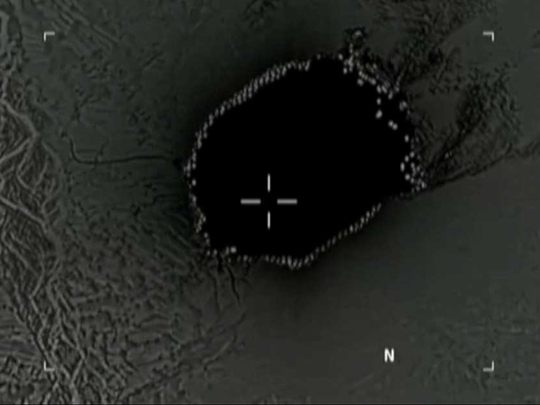
JALALABAD: The death toll from the American military’s largest non-nuclear bomb nearly tripled on Saturday, with Afghan officials saying 94 Daesh fighters were killed, as US-led forces conducted clean-up operations over the rugged terrain.
The GBU-43/B Massive Ordnance Air Blast bomb — dubbed the “mother of all bombs” — was unleashed in combat for the first time, hitting Daesh positions in eastern Nangarhar province on Thursday.
The bombing triggered shock waves in Afghanistan, with some condemning the use of Afghanistan as what they called a testing ground for the weapon, and against a terrorist group that is not considered a threat as big as the resurgent Taliban.
“At least 92 Daesh fighters were killed in the bombing,” Achin district governor Esmail Shinwari told AFP on Saturday. Nangarhar provincial spokesman Attaullah Khogyani gave a toll of 94.
Afghan officials had earlier said the bombing had killed 36 Daesh fighters.
The bomb smashed the Daesh’s remote mountain hideouts, a tunnel-and-cave complex that had been mined against conventional ground attacks, engulfing the remote area in a huge mushroom cloud and towering flames.
Shinwari insisted there were “no military and civilian casualties at all”.
Security experts say Daesh had built their redoubts close to civilian homes, but the government said thousands of local families had already fled the area in recent months of fighting.
The massive bomb was dropped after fighting intensified over the past week and US-backed ground forces struggled to advance on the area. An American special forces soldier was killed last Saturday in Nangarhar while conducting anti-Daesh operations.
President Ashraf Ghani threw his support behind the bombardment, saying it was “designed to support the efforts of the Afghan National Security Forces (ANSF) and US forces conducting clearance operations in the region.”
But some analysts called the action “disproportionate”.
“The Trump administration made a lot of noise with this bomb, but the general state of play on the ground remains the same: The Taliban continues to wage a formidable and ferocious insurgency. Daesh, by comparison, is a sideshow,” Michael Kugelman of the Woodrow Wilson Centre in Washington told AFP, using an alternative acronym for IS.
“Still, from a strategic standpoint, there is an unsettling takeaway here: The US pulled off a huge shock and awe mission against an enemy that isn’t even the top threat to the US in Afghanistan. The Taliban continues to sit pretty.”
Daesh, notorious for its reign of terror in Syria and Iraq, has made inroads into Afghanistan in recent years, attracting disaffected members of the Pakistani and Afghan Taliban as well as Uzbek Islamists.
But the group has been steadily losing ground in the face of heavy pressure both from US air strikes and a ground offensive led by Afghan forces.












